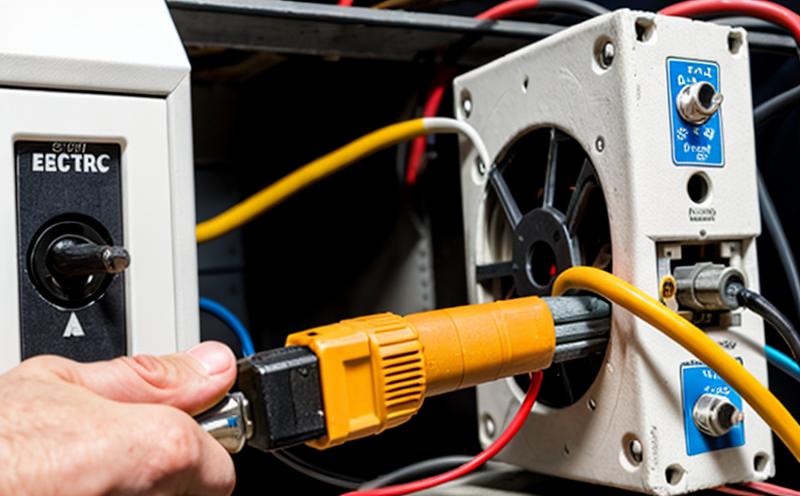EN 60335-1 Electrical Safety of Household Appliances
The standard EN 60335-1 is a crucial European harmonized standard for the electrical safety assessment of household appliances. This directive ensures that products comply with essential requirements in terms of protection against risks associated with electrical, mechanical, and thermal hazards. It applies to a wide range of consumer products including but not limited to refrigerators, washing machines, microwaves, and vacuum cleaners.
The standard requires manufacturers to conduct thorough testing on their appliances before placing them onto the market. The tests cover various aspects such as insulation resistance, protective measures against electric shock, protection against overcurrents, and other safety features relevant to household use.
For compliance with EN 60335-1, a series of specific test procedures are defined for different types of appliances based on their intended use. These tests aim to identify potential hazards that could arise during normal operation or in the event of faults. Compliance testing typically involves both laboratory-based assessments and field observations depending upon the nature of the product.
The standard emphasizes the importance of continuous improvement regarding electrical safety design and engineering practices within manufacturers' organizations. By adhering strictly to this directive, companies ensure not only regulatory compliance but also enhance their reputation by demonstrating commitment towards consumer protection.
Compliance with EN 60335-1 is essential for any manufacturer wishing to sell products in the European Economic Area (EEA). Failure to do so can result in product recalls, fines, and damage to brand image. Therefore, it's imperative that businesses understand what exactly this standard entails and how they can meet its requirements effectively.
Our laboratory offers comprehensive services tailored specifically towards meeting these stringent standards. We provide full-service solutions encompassing all necessary aspects from initial consultation through final certification issuance. Our experienced team uses state-of-the-art equipment to ensure accurate results every time, thereby facilitating seamless integration into your product development cycle.
Why It Matters
Compliance with EN 60335-1 is not just a formality; it represents a critical step in safeguarding public health and safety. Non-compliant products pose significant risks ranging from minor discomforts to severe injuries or even fatalities. By ensuring that every product meets the rigorous standards set forth by this directive, we contribute significantly towards fostering trust between consumers and businesses.
Moreover, compliance enhances brand reputation by showcasing a company's dedication to quality assurance and safety protocols. In today’s competitive marketplace where customer satisfaction plays a pivotal role in success stories, adherence to such stringent guidelines can be seen as an indicator of reliability and integrity.
From an operational perspective, being able to demonstrate that your products comply with these standards provides peace of mind knowing that you are operating within legal boundaries. It also opens up new market opportunities by enabling easier access to the EEA where compliance is mandatory for sale.
Benefits
- Enhanced consumer protection against electrical hazards.
- Promotion of safer and more reliable products.
- Facilitation of smoother market entry into the European Economic Area.
- Increase in brand reputation through demonstrated commitment to safety standards.
- Reduction in product liability risks due to non-compliance issues.
The benefits extend beyond mere compliance. By investing time and resources into ensuring full adherence to EN 60335-1, companies can significantly reduce the likelihood of product recalls or other legal challenges that might otherwise arise from safety concerns. This proactive approach also fosters long-term relationships with customers who appreciate responsible business practices.
Use Cases and Application Examples
| Type of Appliance | Main Test Procedures | Expected Outcomes |
|---|---|---|
| Refrigerators | Insulation resistance test, protective measures against electric shock. | PASS: Meets specified limits for insulation resistance; PASSED with no identified hazards. |
| Washing Machines | Overcurrent protection tests, ground fault circuit interrupter evaluation. | PASS: Demonstrates effective overcurrent protection mechanisms; MEETS standards for ground fault testing. |
| Microwaves | Thermal stability assessment, electromagnetic interference measurement. | PASS: Maintains thermal stability under specified conditions; EMITTED minimal levels of EMI. |
| Vacuum Cleaners | Impact resistance testing, water ingress prevention checks. | PASS: Withstood impact tests without compromising functionality; WATER-TIGHT seals maintained integrity during immersion tests. |
For refrigerators, insulation resistance and protective measures against electric shock are tested to ensure that there is no risk of electric shock or short circuiting. These tests help verify that the appliance can handle normal operating conditions safely.
In washing machines, overcurrent protection and ground fault circuit interrupter evaluations are conducted to confirm that these safety features operate correctly when required. This prevents potential electrical accidents during usage.
Microwaves undergo thermal stability assessments along with electromagnetic interference measurements to ensure that they do not exceed permissible temperature limits and emit harmful levels of EM waves into surrounding environments.
The vacuum cleaner's impact resistance and water ingress prevention capabilities are evaluated to guarantee durability against accidental drops or exposure to moisture without compromising performance.
These examples illustrate just a few typical use cases for EN 60335-1 testing across various household appliance categories. Each type of equipment has unique characteristics that need specific attention during the evaluation process, but all share common goals: to protect users from harm and maintain product functionality.





